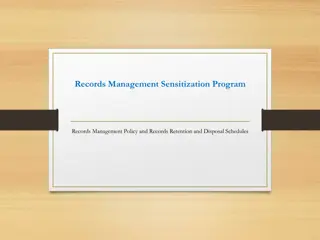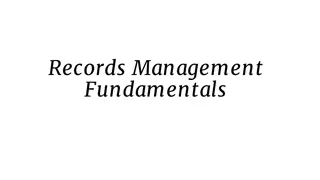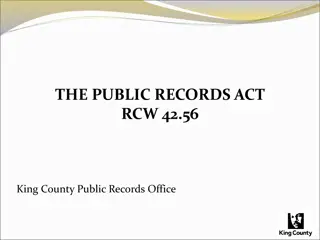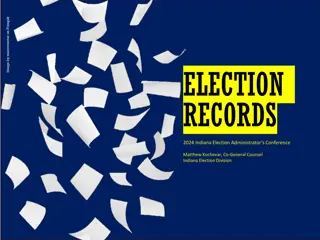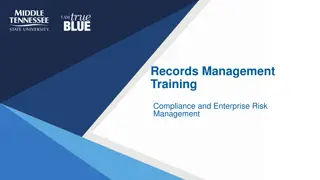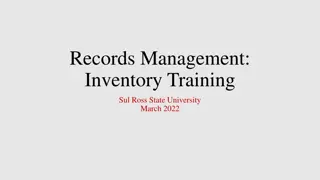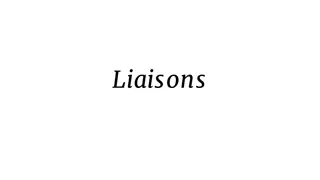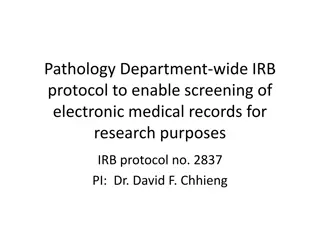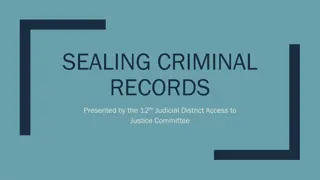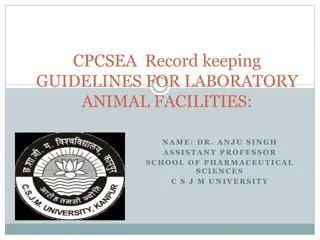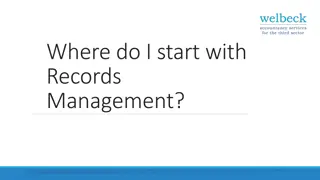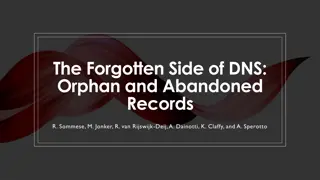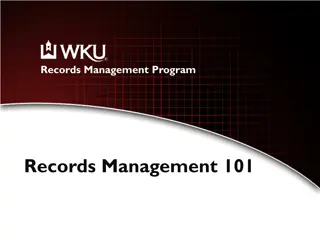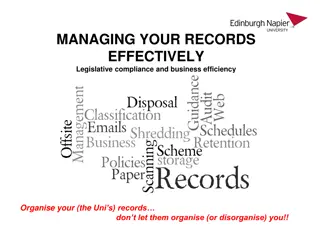Records Management Fundamentals Training Overview
This overview provides insights into a training course on Records Management Fundamentals, designed to educate Agency staff on their responsibilities in managing Federal records. It covers the importance of records management, identification of federal records, fundamental management principles, and available resources. By following the provided guidelines, agencies can tailor the training to meet their specific needs without requiring approval from NARA. The course aims to enhance knowledge and compliance with records management regulations.
Download Presentation

Please find below an Image/Link to download the presentation.
The content on the website is provided AS IS for your information and personal use only. It may not be sold, licensed, or shared on other websites without obtaining consent from the author.If you encounter any issues during the download, it is possible that the publisher has removed the file from their server.
You are allowed to download the files provided on this website for personal or commercial use, subject to the condition that they are used lawfully. All files are the property of their respective owners.
The content on the website is provided AS IS for your information and personal use only. It may not be sold, licensed, or shared on other websites without obtaining consent from the author.
E N D
Presentation Transcript
Records Management Fundamentals
Instructions These slides should be used as a starting point for building tailored Agency specific training for your Agency staff. Following this template will assist AROs in meeting the minimum recommendations of: NARA Bulletin 2017-01 Tailored agency specific training 36 CFR 1220.34(f ) Follow the instructions in brackets throughout the course, add your Agency template, and customize it to meet the needs of your Agency records management program. No approval is needed from NARA to customize and implement this training.
Welcome Welcome to the Records Management Fundamentals Course. This course is designed to help you know your basic responsibilities for managing federal records, including the laws, policies and procedures that govern Federal records management. You will learn how to determine if the information that you work with is considered a Federal record, how to manage Federal records, and what resources you can consult to get more information about records management.
Goals of this training Know your Records Management (RM) responsibilities Determine how to identify a federal record Understand fundamentals about how to manage records Identify resources to help with RM
Why Records Management Matters Lesson 1
Telling the Nation's Story The work you are doing today, captured in your records, may be saved forever to allow historians to understand how your agency and your work contributed to the nation. Federal Government records tell the story of the actions taken by the government and provide us with the history of the nation. Records help citizens hold the government and government officials accountable for their actions. They enable us to accurately understand our past and who we are as a nation.
Records Management at [INSERT YOUR AGENCY/DEPT/OFFICE TITLE and ORG CODE HERE] Contributes to the smooth operation of Agency programs by making readily available the information needed for decision- making and operational readiness Facilitates the effective performance of program activities Protects the rights of citizens, businesses, and the Agency Provides continuity in the event of a disaster Protects information from inappropriate and unauthorized access Helps the agency meet statutory and regulatory requirements
What is Records Management? Lesson 2
Records Management is: The planning, controlling, directing, organizing, training, promoting, and other managerial activities involved with respect to records creation, records maintenance and use, and records disposition in order to achieve adequate and proper documentation of the policies and transactions of the Federal government and effective and economical management of Agency operations. 36 CFR 1220.14
What that really means is..... We are required to create and manage information that documents our work, safeguard information that needs to be protected, and keep or dispose of records according to an approved records schedule. A records schedule is a document that tells you how long to keep specific types of records and what should happen to those records when you no longer need them.
Roles and Responsibilities Lesson 3
Roles and Responsibilities In the past, most Federal records were created in print. Now, however, most government information is created and maintained electronically. Regardless of format, the basic rules of records management are the same for all forms of media that contain Federal information. Those rules are codified in the law and Federal regulations. To supplement these laws our Agency has created the following [Insert proper term for your agency : policy, directives, instructions, guidance etc]. [Insert hyperlink(s) to YOUR AGENCY's RM policy documents and/OR other relevant documents]
Its the Law 44 U.S.C., Chapter 31 We are required to create and manage information that documents our work, safeguard information that needs to be protected, and keep or dispose of records according to an approved records schedule.
Title 44 U.S.C., Chapter 31 The head of each Federal agency shall: 3105 Establish safeguards against the removal or loss of records they determine to be necessary and required by regulations of the Archivist. Safeguards shall include making it known to the officials and employees of the agency- 3101 Make and preserve records containing adequate and proper documentation of the organization, functions, policies, decisions, procedures, and essential transactions of the agency and designed to furnish the information necessary to protect the legal and financial rights of the Government and of persons directly affected by the agency s activities. (1) that records in the custody of the agency are not to be alienated or destroyed except in accordance with sections 3301-3314 of this title, and (2) the penalties provided by law for the unlawful removal or destruction of records.
Records Management at [Insert Your Agency Name] Employees and Contractors will: Organize files in a manner that facilitates efficient and effective retrieval of information Coordinate with [Insert name and title as well as hyperlink to contact information for your Agency RM staff and/or Agency Records Officer] regarding all aspects of RM, including schedules and dispositions
Employees and Contractors will NOT Remove or destroy records from offices without authorization and an approved schedule Mix official records with contractor records, personal information, or non-record materials Share or distribute government records and information with non-government entities without prior approval Destroy unscheduled records
Unscheduled Records Unscheduled records are records that are not covered by an approved records schedule. Unscheduled records are treated as PERMANENT records until a NARA approved retention schedule has been implemented.
Office/Program Managers Office/Program Managers must: Perform reviews of RM activities and help ensure compliance with legal and regulatory requirements Identify the official office of record Specify if the data being created is a record Apply appropriate disposition instructions for files being created
Roles Specific to Records Management Records Custodians: Office staff who do Records Management at the lowest level (program/project/office) in your Agency Records Liaisons: Staff who manage records at the division level (intermediate program/project/ Division/Unit) in your Agency Agency Records Officer (ARO): person who heads an Agency's Records Management Program Mission Specialist: Employees who have their own set of Records Management roles and responsibilities outlined for them.
Role: [Insert what your Agency calls these staff] [Office staff who do Records Management at the lowest level (program/project/office) in your Agency] NARA calls these staff Records Custodians Records Custodians should be able to: Apply a records/retention schedule Understand the agency RM staff structure Know and understand Agency RM policy and guidance. Coordinate with Records Liaisons Understand records storage operations regardless of record format. 1. 2. These staff manage records at the office level. 3. These are usually not the admin staff s regular duties. 4. 5. [Add Agency specific info on the role and responsibilities of Records Custodians at your agency] [Add links to any documents specific to Records Custodians] For more information please contact your ARO.
Role: [Insert what your Agency calls these staff] [Staff who manage records at the division level (intermediate program/project/ Division/Unit) in your Agency] NARA calls these staff Records Liaisons Records Liaisons should be able to do: 1. 2. Apply a records/retention schedule Know and understand Agency RM policy and guidance/ evaluate implementation Control of share drives (If assigned) Complete a records inventory (regardless of format) Create file plans (regardless of format) Communicate/Coordinate with Agency Records Officer Be familiar with NARA RM regs Conduct RM training for Agency staff These staff manage records at the Division level. These are usually not admin staff s regular duties. 3. 4. [Add Agency specific info on the role and responsibilities of Records Liaisons at your agency] 5. 6. 7. 8. [Add links to any documents specific to Records Liaisons] For more information please contact your ARO.
Role: Agency Records Officer Manages the records management program, establishes polices and procedures, and coordinates records management matters.
Role: [Insert Mission Specialist Job title] Each set of employees who do a specific mission at your agency should have their own set of Records Management roles and responsibilities outlined for them. These mission specialists should be able to: Be aware of their RM responsibilities and how it applies to them Apply the records/retention schedule that covers their particular function Apply the office s files plans and any classification issues surrounding their records Know the appropriate RM staff contact info for additional guidance Know what goes into a Records Series / Agency specific information These groups have records that specifically apply to them. Examples: Senior level agency officials and political appointees Records professionals at all levels within the organization Managers and supervisors Acquisition, contracting, and procurement personnel Attorneys engaged in litigation or advising on records or access to information issues Personnel developing and managing IT systems and applications Continuity of Operations and Disaster Preparedness personnel that manage mission essential records These groups may have specific training needs. For more information please contact your ARO. For additional training on your specific RM responsibilities, contact [Insert your Agency's Records Officer s contact information]
What Are Records, Non Record Materials, and Personal Papers? Lesson 4
What is a Federal Record? Federal Records are any recorded information, regardless of form or characteristics that are .. Examples Include: [Insert examples of your agency's federal records] Made or received by a Federal agency under Federal law Made or received by a Federal agency in connection with the transaction of public business Preserved or appropriate for preservation by a Federal agency or its legitimate successor as evidence of the activities of the U.S. government or because of the informational value
What is Recorded Information? Recorded information is defined as: ...all traditional forms of records, regardless of physical form or characteristics, including information created, manipulated, communicated, or stored in digital or electronic form. 44 U.S.C., 3301, Definition of a Federal Record
Is It a Record? Ask Yourself Examples Include: Was it made or received for official business? 1. [Insert examples of Federal records created at your agency; specific to a role] 2. Does it provide evidentiary support for any of my agency s: policies functions decisions procedures missions programs projects or activities
What are Non-Record Materials? Examples Include: Non-record materials are defined as: [Insert examples of non-records created/used at your agency] ...Library and museum material made or acquired and preserved solely for reference or exhibition purposes, extra copies of documents preserved only for convenience of reference, and stocks of publications and of processed documents. 44 U.S.C., 3301, Definition of a Federal Record
Non-Record Materials Keep in mind that non-record materials are still owned by the agency. Therefore, the materials may have evidentiary value and still need to be turned over for Freedom of Information Act (FOIA) requests. Examples include: Duplicates of documents maintained in the official files and extra copies of correspondence Documents used only for reference or exhibition purpose Catalogs, trade journals and other reference materials Stocks of publications [Insert your agency specific examples here]
What are Personal Papers? Personal papers or files are documentary materials owned by an official or staff member that are not used in the transaction of agency business but that may be in a government office. Personal papers are: Examples include: [Insert your agency specific examples here] Employee copies of their performance appraisal and personnel actions Non-work related email to a friend Magazine article you brought to the office Related solely to an individual's private affairs Not used for agency business Kept separate from agency record and non-record materials Labeled as personal files
Records Lifecycle Lesson 5
Records Lifecycle Phases Records managers often use a model called the Records Lifecycle to describe how a record is handled throughout its lifespan. The records life cycle has three main phases. 1. Create and Receive 2. Maintenance and Use 3. Disposition
Step 1: Create and Receive This includes the capture of records in order to provide adequate and proper documentation of government activities. This includes: Capturing information about the record Connecting related records Identifying the correct records schedule for the record
Step 2: Maintenance and Use This includes: Storing and retrieving records Using records for daily business Securing records and backing up electronic files Choosing good on-site and off-site storage Protecting the accuracy and authenticity of the information Ensuring electronic records are migrated to readable formats when a system of software becomes outdated
Step 3: Disposition This includes: Following the disposition instructions on the records schedule Transferring inactive records to off-site storage Destruction of temporary records Transfer and accessioning of permanent records into the National Archives
Disposition of Records Lesson 6
Disposition What happens to a record at the end of the lifecycle is determined by how valuable the record is to preserving history or the rights and interests of citizens. Most records are considered temporary. Those records are destroyed after they are no longer needed for agency business. A very small percentage of records are considered permanent and are transferred to the National Archives to be kept forever.
Four Types of Records The following sections will provide general guidance on the disposition of 4 types of records: Temporary records Permanent records Unscheduled records Records on legal hold
Temporary Records The records: Examples include: Are destroyed/deleted after a NARA-approved retention period Often require off-site storage when inactive May be kept past the destruction date because of a legal hold or other valid business need Time and attendance files Employee travel documents Procurement files Budget and general accounting files Grant files [Insert your agency specific examples here]
Permanent records Examples include: The records: Executive correspondence of high-level senior officials Directives and policy documents Official USDA reports, decisions, press releases High-level committee files Operating Administration organizational charts Insert your agency specific examples here] Have historical value or other value that warrants permanent preservation Require special care and handling Are eventually transferred to the National Archives Are stored as part of our national history
Unscheduled The records: Are not covered by an approved records schedule Do not have an approved disposition Must be treated as permanent records until a disposition is approved by NARA
Legal Holds Legal holds can affect how long a record must be retained. A legal hold is a communication issued as a result of current or anticipated litigation, audit, Federal government investigation, Congressional inquiry, FOIA request, Privacy Act request, or similar action Legal holds require agencies to keep records until the legal issue is resolved May also be called a hold order, freeze notice, preservation order, or suspension order Agency records personnel will know if any records are under a legal hold
Records Schedules and Storage Lesson 7
Legal Authority The National Archives and Records Administration is the legal authority for what gets saved and what gets destroyed. Our NARA approved records schedules describe our records, how long to keep the records and what to do when we no longer need them. In this lesson, you'll learn a little about records schedules and the file plans that we use at [Insert your Agency/Unit/Office name] to guide how we organize and maintain our records.
Records Schedules In the Federal government there are two types of records schedules that govern how long an agency keeps its records. General Records Schedules (GRS) cover administrative files that are common to most agencies. Agency specific records schedules cover records that are unique to the agency mission. [Insert link to Agency Records Schedules and file plans] [What is a records schedule? provide link to module on the NARA website]
Agency File Plans A file plan provides similar information as the record schedules and is designed to provide instructions for how to handle the records in an office or agency. At [Insert Agency], the information about how long to keep records is in the file plans for each office. The file plans contain a description of the records, the retention period, the records schedule authority for the records, and whether the records are temporary or permanent. Contact your Agency Records Officer to get a copy of the file plan.
Records Storage [Insert agency specific storage information here] Our records are initially stored at Agency offices for one year after the fiscal year is over. After that, we store the temporary records at a NARA Federal Records Center or NARA approved storage facility for the duration of the retention period. At the end of the retention period, permanent records are transferred to NARA for preservation in the National Archives. Temporary records are destroyed or deleted.
Capstone Approach to the Management of Email Records Lesson 8
Capstone Capstone is a simplified approach to managing email records. It is based on the position or role of the email account owner and applies to all official email accounts of those positions. [Insert Agency] uses the Capstone approach to manage email for the agency. The Capstone approach includes high level officials, who's email is a permanent record, as well as all other email accounts, which are scheduled by the role of the person according to GRS 6.1. Capstone applies to anyone who creates, receives, and handles federal records, including contractors and sub- contractors.
Common Issues and Best Practices Lesson 8




